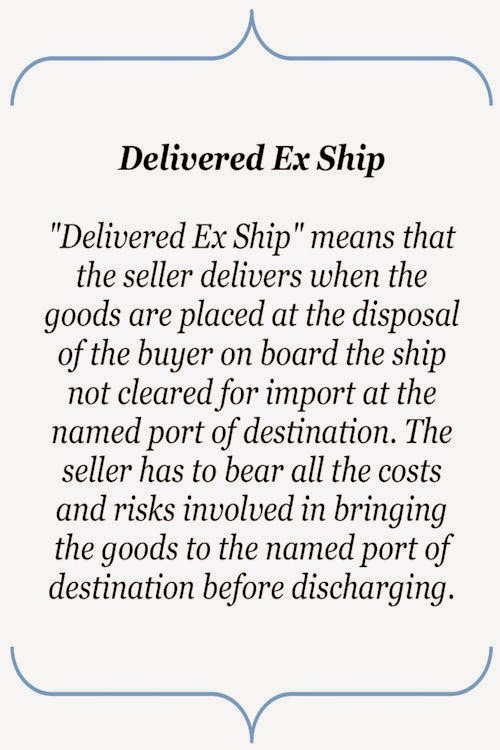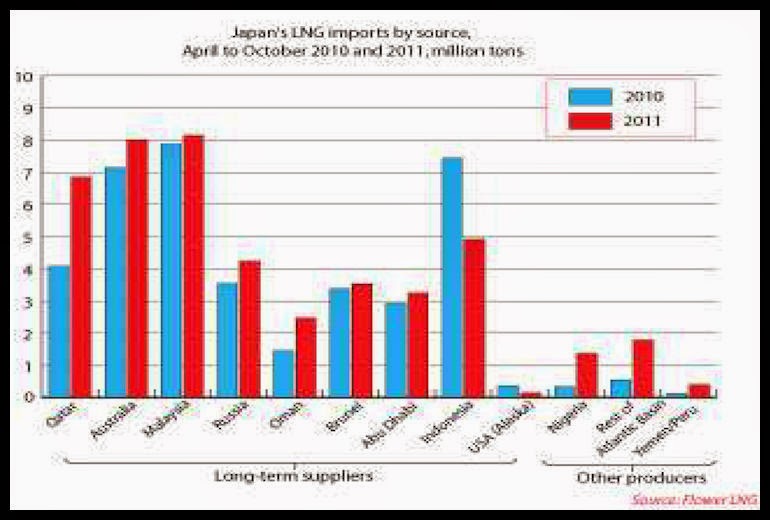December 22, 2011
On Wednesday December 7, 2011, Qatargas, the world's largest
L.N.G. company owing a total annual capacity of 42 million tons, signed a
tripartite sales and purchase agreement (S.P.A.) with Japan's Chubu Electric
Power Company (the electric provider for the middle Chubu region of the Honshu
island) and Shizuoka Gas (one of the 211 city gas distributors in Japan with a
business area covering 10 municipalities between Tokyo and Nagoya). The Qatari
L.N.G. producer, founded in 1984, has an established relation with Japan and
its first L.N.G. shipment abroad, dating back to 1997, was delivered exactly to
Japan.
This new deal was announced during the World Petroleum
Congress in Doha, Qatar (December 4-8, 2011) and was signed by the Qatari
minister of energy and industry, Mohammed Bin Saleh Al Sada, Chubu Electric
Power Company's general manager of the fuels department, Yuji Kakimi and
Shizouka Gas' chairman and C.E.O., Seigo Iwasaki. Qatargas is already exporting
to Japan 10 million tons of L.N.G. per year. This new deal will last for five
years from 2016 to 2021 and according to the agreement every year Qatargas will
be supplying to the Japanese companies 200,000 tons of L.N.G. (the final
supplied quantity will be approximately 1,200,000 tons). The two companies will
decide how to share the L.N.G. This will be delivered ex-ship to the following
group of receiving terminals: Chita, Kawagoe, Yokkaichi, Joetsu and Sodeshi.
Also for this new S.P.A. the Qatari L.N.G. will be shipped
from Qatargas 1, which has three trains (with an annual production of 2 million
tons each) and is a joint venture with several stakeholders: state-owned Qatar
Petroleum, U.S. ExxonMobil, France's Total and Japan's trading houses Mitsui
and Marubeni.
“This agreement is remarkable in many aspects. It further
nurtures our long lasting relationship with Chubu Electric Power Company while
it welcomes Shizuoka Gas Company as the first new long-term Japanese buyer of
L.N.G., in addition to those eight buyers which formed the currently existing
consortium purchasing L.N.G. from Qatargas 1 joint venture for contracts signed
in 1992 and 1994. It is also an example of how Qatargas can grow its share of
the Japanese gas market in partnership with Chubu Electric Power Company” said
Qatargas's C.E.O., Khalid Bin Khalifa Al-Thani. He also specified that
"this agreement is further testimony of our long-term reliable commitment
to Japan and the innovative ways in which Qatargas is able support new
customers. Whether for a very large sale of L.N.G. or for a smaller volume like
under this Tripartite S.P.A., Qatargas values all of its customers and seeks to
assist them all in their aspirations to grow in the future.”
It should be underlined that during the World Petroleum
Congress in Doha two other Qatari companies accomplished important results.
Qatar's RasGas, the world's second largest L.N.G. producer after QatarGas, made
public a contract with Taiwan's C.P.C. Corporation aimed at shipping 1.5
million tons per annum of Qatari L.N.G. This deal will have a 20-year duration.
Moreover, Qatar Petroleum signed a memorandum of understanding (M.O.U.) with
U.K. Centrica aimed at investments in upstream assets, facilities for gas
storage, combined-cycle gas turbine generation assets and downstream
opportunities. Still in 2011, Centrica had previously signed a three-year
contract (valued $3.1 billion) with Qatar's state oil company, Qatar Petroleum
International (Q.P.I., it's the international investment division of Qatar
Petroleum) in order to receive 2.4 million tons per annum of L.N.G. Centrica
has been having an established commercial relation with Qatar since 2003.
In recent years, Qatar has increased its L.N.G. supplies to both
Europe and Asia. This was possible thanks to new facilities that were ready at
the end of the 2010s. Japan has been buying L.N.G. for decades and now, after
the Fukushima disaster of March 2011, L.N.G. imports will increase. In fact,
the country is implementing some stress tests for all of the Japanese nuclear
power plants while at the same time some nuclear plants are shut down for
inspection and maintenance. At the end of November 2011, only 10 out of 54 nuclear units were in operations. It's
quite evident that Japan's power companies are boosting their gas purchases.
And L.N.G. is the best currently available solution. Estimates envisage for
Japan a 2011 L.N.G. demand increase by at least 12 million tons. And Daisuke
Harada, deputy general manager of Japan Oil, Gas and Metals National
Corporation (Jogmec), has recently stated in 20 million tons the additional
L.N.G. demand for 2012 if some nuclear reactors do not restart operations.
Data about L.N.G. imports for the period April-October
2011 showed a relevant increase of L.N.G.
imports in comparison to the same months in 2010. The above graph from Flower
L.N.G., a consultancy, well illustrates this trend. From April 2011 to October
2011, Qatar supplied almost 7 million tons of L.N.G., in practice 2.77
million tons more than the same period in 2010 (65.4 percent increase only from
Qatar). Similarly, the other L.N.G. producers of the Atlantic Basin, not
including Libya, increased their shipments (+1.24 million tons) as well as
did the two newest L.N.G. producers, Peru and Yemen (+0.27 million tons).
Still, with reference to the period April-October 2011, among the long-term
suppliers, apart from Qatar that increased by 65 percent its L.N.G.
exports, also Australia (+0.87 million tons), Russia (+0.7 million tons) and
Oman (+1.01 million tons) shipped more L.N.G. to Japan. At the same time,
Japan received less L.N.G. from Indonesia (-2.51 million tons) and Alaska
(-0.21 million tons). Among the other producers (those not bound through a
long-term agreement), it's important to consider Nigeria (+1.03 million tons).
According to Japan's Ministry of Finance, in October 2011
the country overall imported 6.12 million tons of L.N.G. with a 17.9 percent
increase in comparison to October 2010 (the highest annual increase since
August 2011, when Japan imported a record 7.55 million tons meaning a 18.2
percent increase than the August 2010 imports). Considering these data, it's
highly probable that adding all the involved exporters, Japan's L.N.G. imports
for 2011 will reach the amount of 78 million tons to 80 million tons from 70
million tons in 2010 (with at least a 10 percent increase).
These Japanese purchases will not be without consequences in
Asia. In fact, already few days ago, Nanang Untung, senior vice president of
Indonesia's Gas PT Pertamina (Persero) stated that Qatar seems currently less
attracted by the idea of exporting its L.N.G. to Indonesia than by the idea of
exporting to Japan. This could very soon be a problem for Indonesia, which has
recently encouraged the procurement of floating storage regasification units
(F.S.R.U.s). These units are the three F.S.R.U.s located in Belawan, Teluk
Jakarta and East Java (each has a capacity of 3 million tons per year). It's
quite evident that at least the F.S.R.U. in East Java could experience a
shortage of L.N.G. supply (up to now it has not secured any L.N.G. supply). All
this situation derives from the fact that Japan — given the strategic
importance for its economy of L.N.G. — is capable of purchasing L.N.G. at the
price of $14 per million British thermal unit (MMBtu), while Indonesia may
arrived at $11 per MMBtu (Japanese price is 27.2 percent higher than the
Indonesian price). Obviously, high prices will soon put some stress on the
business results of the Japanese power producers, but viable alternatives do
not abound. And rates for the December 2011 L.N.G. delivery is from $17 per
MMBtu to $17.50 MMBtu.
With no doubt, Qatar with its production capacity of 77
million tons of L.N.G. per year (by far the largest L.N.G. exporter in the
world) could profit from the upsurge of L.N.G. prices in the short-to
medium-term in the Asia-Pacific Region. In 2012, Japan and South Korea will
necessitate probably 25 million metric tons, which could rise to 49 million
tons in 2015 according to report released in December 2011 by Credit Suisse, a
Swiss bank. Not to mention an increase in the Chinese and Indian L.N.G. needs.
And this gas will come from Qatar. In fact, in the near term, the only player
capable of increasing its exports catching the L.N.G. demand without a
long-term contract is Qatar. Geographically speaking, Australia could supply
the Asia-Pacific Region, but its new liquefaction plants (among them Gorgon and
Queensland Curtis) won't be ready before 2014 with no significant contribution
to global L.N.G. production before 2015. Russia, already an L.N.G. seller to
Japan, would be an obvious candidate to supply additional tons of gas. In fact,
for Russia it's preferable selling gas to Japan and South Korea than to China.
Apart from Russia's gas projects in the Pacific also the Yamal L.N.G. project,
located in the Yamal Peninsula (facing the Arctic Ocean), is developed
targeting Asian buyers and one of them could certainly be Japan. And in order
to partially lower L.N.G. prices it could also be of huge utility for Japan to
have different sellers like Qatar, Australia and Russia. The problem is that
apart from Sakhalin-2, which already well serves Japan, the other Russian
L.N.G. projects will take time before being operative.
In other words, up to 2015 the real player with monopoly
power in relations to short-term supply to be delivered to Asia — and
consequently to Japan — will be Qatar. Now, the real job for the Gulf country
will be to convert short-term supply into long-term supply based onto long-term
contracts. The 2.77 million tons increase in L.N.G. sold to Japan from April to
October were mainly diverted cargoes, which initially were supposed to ship
L.N.G. volumes to Europe. At this regard, in September 2011, Qatar publicized
plans of doubling its long-term contracts to Asian countries in the next years
up to 20 million metric tons annually. In the end, at least for the next three
years, Qatar has now metaphorically and concretely the power of moving the
rudder.





